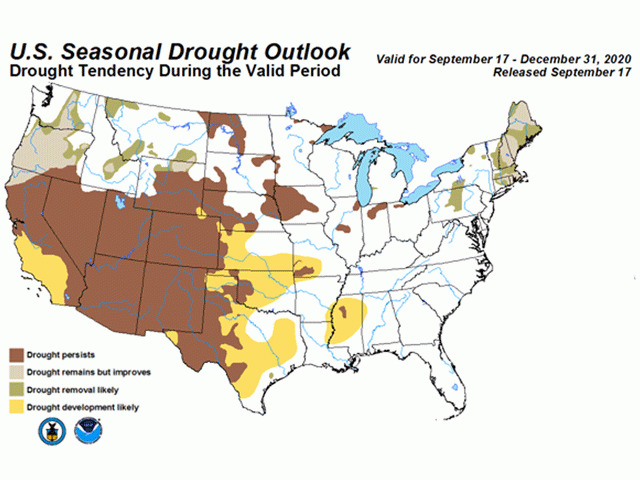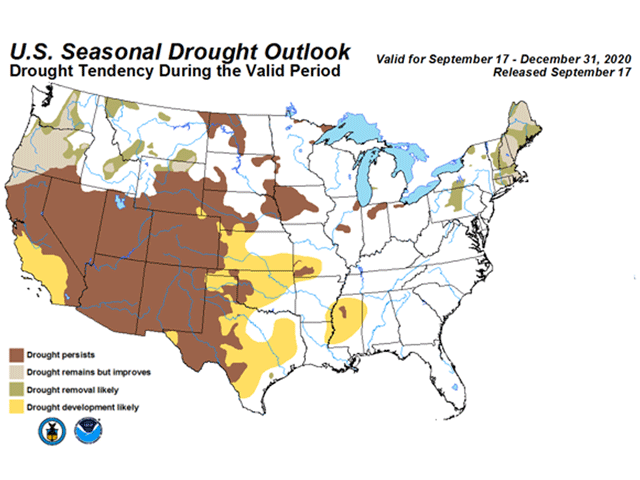Ag Weather Forum
Drought to Expand During Fall 2020
OMAHA (DTN) -- A turn from very wet to very dry conditions in the central U.S. during 2020 is forecast to continue through the end of the year.
The official NOAA mid-September outlook calls for no drought easing in affected areas of the Midwest and Plains over the next three months. In fact, the outlook calls for drought to expand from the western Plains eastward to the Delta. In addition, no letup is expected in drought in the western Midwest and portions of the Northern Plains.
Brian Fuchs, a geoscientist at the National Drought Mitigation Center in Lincoln, Nebraska, said that drought conditions in the central U.S. are the highest in more than five years.
"We haven't seen this extent of drought since 2013," Fuchs said on a regional forecast conference call.
Going through the balance of 2020, Fuchs noted that forecasts have a strong signal for below-normal precipitation in the Southern Plains and Delta. This drier trend leads to a forecast for drought to cover this entire segment of the contiguous U.S. At the same time, drought-affected areas in the Midwest have equal chances for above-normal, normal or below-normal precipitation, leading to a prediction of continued drought through December 2020.
P[L1] D[0x0] M[300x250] OOP[F] ADUNIT[] T[]
DTN forecasts lean even drier with expectations for below-normal precipitation through almost all the central and eastern U.S. except for northern New England.
This dry trend makes the next six weeks or so before cold temperatures freeze the soils very important. That's the soil moisture recharge season -- the time between the end of the crop-growing cycle and the onset of cold conditions.
"We need to look for moisture before the soil freezes," Fuchs said.
USDA Midwest Climate Hub Director Dennis Todey is concerned about dry conditions staying in effect for at least several months.
"We have a ways to go before I'll be feeling good about moisture," he said.
Pacific Ocean water temperatures cooling to the point of developing a La Nina temperature pattern are also getting more attention. La Nina has a strong correlation to dry conditions in the Southern Plains during the following months after the beginning of a La Nina event.
Todey conducted research at Iowa State University on La Nina and its impact on central U.S. weather.
"The stronger La Nina is, the better the likelihood is that we'll see these (expected) trends," Todey said.
The extensive drier areas expected over the Southern U.S. also have the prospect of continuing into spring 2021.
"The likelihood is quite high" that a drier winter and possibly drier spring are in store, said the Drought Mitigation Center's Brian Fuchs. "When it's drier to the south, any moist air moving north from the Gulf of Mexico tends to lose its moisture as it moves north," he said.
Bryce Anderson can be reached at bryce.anderson@dtn.com
Follow him on Twitter @BAndersonDTN
© (c) Copyright 2020 DTN, LLC. All rights reserved.






Comments
To comment, please Log In or Join our Community .